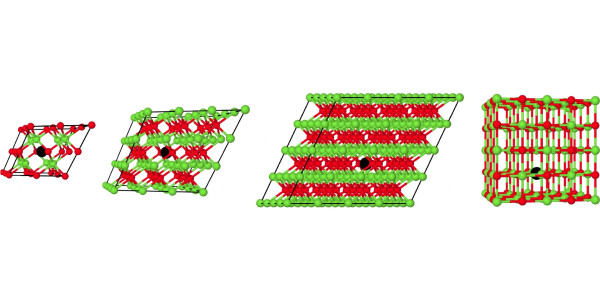How to combine quantum and classical algorithms for materials simulation
By Nicola Nosengo/NCCR MARVEL
Quantum computing holds great promises for materials simulation. Not only because quantum machines – once they become stabler and bigger than they are now - are expected to outperform the computational power of classical computers. But because most computational materials science is about simulating quantum phenomena, such as the behavior of electrons in atoms and molecules, and how magnetic and electric properties arise from them. And what can be better than a quantum system when it comes to simulate another one?
At the same time, quantum computations are hard to manage. Many algorithms have been developed that allow to represent ground and excited-state properties of chemical systems by using qubits, but their execution is beyond the capabilities of current quantum computing devices. That is why many groups are turning to hybrid quantum-classical algorithms, where only a part of the computation is done in a quantum fashion, and classical computing takes care of the rest.
A recent study by MARVEL researchers – from Juerg Hutter’s group at the University of Zurich and Ivano Tavernelli’s one at IBM Research - provides a new and efficient way to use hybrid computation for materials simulation. The study, published in npj Computational Materials, introduces a framework that takes care of “embedding” quantum computations of specific orbitals and electrons in a material within a classical computation, so that the power of quantum computing can be focused on the electrons that are most important for the properties of the material, while keeping the whole calculation manageable.

The four supercells used in the calculations. From left: primitive (2x2x2), primitive (3x3x3), primitive (4x4x4) and conventional (2x2x2) cell of magnesium oxide. Magnesium atoms are in green, oxygen atoms are in red, the oxygen vacancy is colored in black. Battaglia et al, npj Comput Mater (2024).
First author Stefano Battaglia, from the University of Zurich, explains that the first and key step for using the framework is defining the “active space” in a material - essentially, finding the orbitals and electrons that are key for the properties of interest and simulating them at a higher level of detail. The rest of the electrons are considered “inactive” and can be simulated less accurately. The interaction between the active and inactive space is modelled by an embedding potential.
“For example, in magnesium oxide we know that the optical properties of its oxygen vacancy depend on two electrons found in a specific orbital” explains Battaglia. “We can include these electrons in the active space and use quantum computing only for them”.
The method, of course, can work for any material. Once scientists have used their physical and chemical knowledge to select the electrons they need to focus on, the framework created by the study takes care of the rest.
The framework works by interfacing two widely used software tools that belong respectively to the classic and quantum world: CP2K, a quantum chemistry and solid state physics software package developed in Juerg Hutter’s group at the University of Zurich, and Qiskit Nature, an open-source framework commonly used for accessing IBM quantum computers.
The user launches a single computer script that sets both softwares in motion in parallel. CP2K starts the calculation for separating the active and inactive space and how they relate to each other, while Qiskit prepares everything needed to run the calculations, either on a real quantum computer or (as in the case of this study) on a simulated one. When everything is ready the two softwares have a “handhsake” and begin exchanging data. CP2K calculates an initial energy and sends the embedding potential to Qiskit, that builds the Hamiltonian (the quantum representation of the total energy of the system), solves it and sends the updated values to CP2K. The whole thing continues in a loop until the energy is no longer changing from one iteration to the other, at which point the workflow shuts down.
The reason magnesium oxide was chosen for validating the method is that it is a system with a small active space to fit the capacity of current quantum computers, but with an interesting challenge: understanding the way the material absorbs and emits light, that is linked to its neutral oxygen vacancy and that several experimental and computational studies have addressed without getting to a conclusive explanation. The study shows that the results obtained with the new workflow are in very good agreement with the results obtained by state-of-the-art theoretical and experimental methods, in particular when it comes to predicting light emission.
“But this is not the ideal system to show the full potential of embedding, that we think can be used also for more complicated problems” says Battaglia.
As a next step, the group aims to use the method on a bigger system, on real quantum hardware, and with a different quantum algorithm that can handle a much larger active space of up to 50 orbitals, while also improving the theoretical aspects of the embedding method.
Reference
Stefano Battaglia, Max Rossmannek, Vladimir V. Rybkin, Ivano Tavernelli, and Jürg Hutter. A general framework for active space embedding methods with applications in quantum computing. npj Comput Mater 10, 297 (2024). https://doi.org/10.1038/s41524-024-01477-2
Low-volume newsletters, targeted to the scientific and industrial communities.
Subscribe to our newsletter